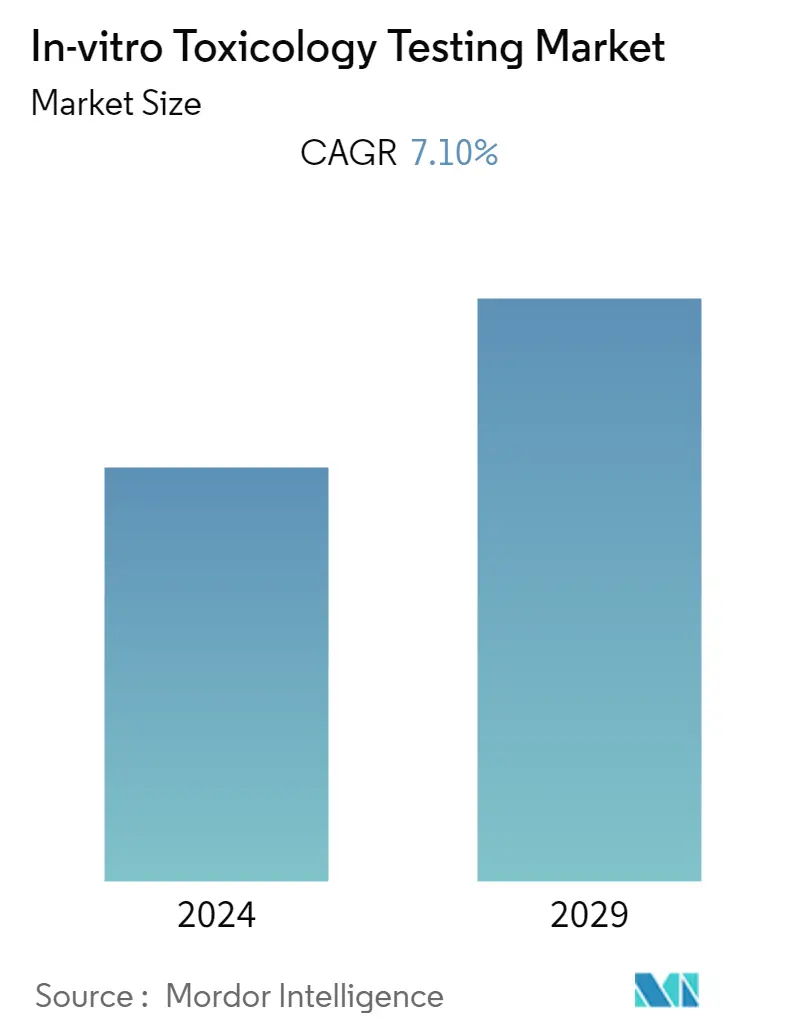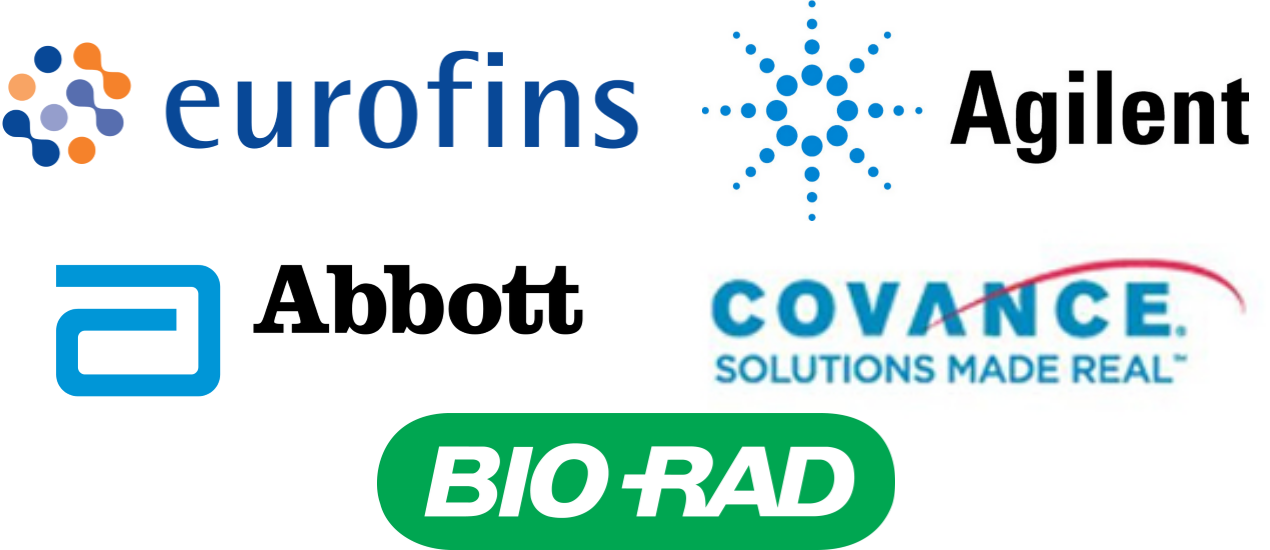Market Size of In-vitro Toxicology Testing Industry

| Study Period | 2019 - 2029 |
| Base Year For Estimation | 2023 |
| CAGR | 7.10 % |
| Fastest Growing Market | Asia Pacific |
| Largest Market | North America |
| Market Concentration | High |
Major Players
*Disclaimer: Major Players sorted in no particular order |
In Vitro Toxicology Testing Market Analysis
The in-vitro toxicology testing market is expected to witness a CAGR of 7.1% during the forecast period. Factors that are driving market growth include the opposition to the use of animals in pre-clinical research, significant advancements in-vitro toxicology assays, and growing awareness regarding drug product safety.
In-vitro tests provide toxicity information in a cost-effective and timesaving manner. It is anticipated that rapid advances in biomedical sciences will result in the development of newer and advanced in-vitro test strategies for hazard characterization. Toxicity testing is slowly becoming proficient with various advanced technologies aiding the process. It is currently poised to take advantage of promising revolutions from the field of biotechnology. The applications of toxicity testing are set to increase with advances in biotechnology, resulting in a demand for the same in the market. The advances in toxicity testing practices, such as bioinformatics, computational toxicology, epigenetics, etc., hold the potential for a paradigm shift from whole-animal testing to in-vitro methods that evaluate changes in various processes, which use cell lines and other cellular components. A number of emerging fields and techniques are contributing major new insights for understanding biologic responses to chemicals in human tissues. These advances are expected to drive the growth of the in-vitro toxicology market during the forecast period.
However, the screening process is quite stringent for the approval of any healthcare molecule. Many molecules fail in the toxicity study stage and are barred from entering the market. In-vitro toxicology testing as an alternative to animal testing is by default always under the lens, as it is intended to replace a fully approved method for toxicity study (animal testing). This is because in-vitro toxicology testing has to match closely to the standards from in-vivo animal testing. Regulators, including the United States Food and Drug Administration (FDA), have issued guidance with regard to in-vitro studies to be conducted during drug development.
However, current regulatory guidance does not address specific study designs for in-vitro toxicity testing. The experimental procedures and documentation of data for in-vitro testing should be rigorous, reproducible, with specific analytical methods, along with documentation of assay procedures and results. Therefore, these stringent regulations are restraining the growth of the in-vitro toxicology testing market, globally. Other factors, such as incapability of in-vitro models to determine autoimmunity and immunostimulation, are also acting as major restraints for the market studied.
In Vitro Toxicology Testing Industry Segmentation
In-vitro toxicity testing is referred to the method of scientifically analyzing the effects of lethal or toxic chemical materials either on mammalian cells or on cultured bacteria. In-vitro testing methods are performed mainly for the purpose of identifying potentially harmful chemicals and/or for confirming the deficiency of certain toxic properties in the initial stages of the development of possibly useful novel substances, including therapeutic drugs, agricultural chemicals, and even food additives.
In-vitro Toxicology Testing Market Size Summary
The in-vitro toxicology testing market is poised for significant growth, driven by the increasing opposition to animal testing in pre-clinical research and advancements in in-vitro assays. These tests offer a cost-effective and efficient means of assessing toxicity, with rapid developments in biomedical sciences paving the way for more sophisticated testing strategies. The market is benefiting from innovations in biotechnology, such as bioinformatics and computational toxicology, which are shifting the focus from traditional animal testing to in-vitro methods. These advancements are enhancing the understanding of biological responses to chemicals, thereby expanding the applications of in-vitro toxicology testing. Despite these positive trends, the market faces challenges due to stringent regulatory requirements and the limitations of in-vitro models in certain areas, such as autoimmunity and immunostimulation.
Regionally, North America is experiencing rapid development in in-vitro toxicology testing, supported by technical advancements and favorable government regulations. Investments in laboratory capabilities and technologies are enabling comprehensive toxicological profiling across various sectors, including pharmaceuticals and cosmetics. Meanwhile, the Asia Pacific region is expected to see the highest growth rate, driven by government initiatives promoting in-vitro testing and the cost-effectiveness of conducting clinical trials in the region. The market is highly competitive, with major players like Abbott Laboratories, Agilent Technologies, and Eurofins Scientific holding significant shares. These companies are actively expanding their market presence through strategic collaborations and entering new regions, further fueling the growth of the in-vitro toxicology testing market.
In-vitro Toxicology Testing Market Size - Table of Contents
-
1. MARKET DYNAMICS
-
1.1 Market Overview
-
1.2 Market Drivers
-
1.2.1 Opposition to the Usage of Animals in Pre-clinical Research
-
1.2.2 Significant Advancements In-vitro Toxicology Assays
-
1.2.3 Increasing Awareness Regarding Drug Product Safety
-
-
1.3 Market Restraints
-
1.3.1 Incapability of In-vitro Models to Determine Autoimmunity and Immunostimulation
-
1.3.2 Stringent Regulatory Framework for the In-vitro Tests
-
-
1.4 Porter's Five Forces Analysis
-
1.4.1 Threat of New Entrants
-
1.4.2 Bargaining Power of Buyers/Consumers
-
1.4.3 Bargaining Power of Suppliers
-
1.4.4 Threat of Substitute Products
-
1.4.5 Intensity of Competitive Rivalry
-
-
-
2. MARKET SEGMENTATION
-
2.1 By Technology
-
2.1.1 Cell Culture
-
2.1.2 High Throughput
-
2.1.3 Molecular Imaging
-
2.1.4 OMICS
-
-
2.2 By Method
-
2.2.1 Cellular Assay
-
2.2.2 Biochemical Assay
-
2.2.3 In Silica
-
2.2.4 Ex-vivo
-
-
2.3 By Application
-
2.3.1 Systemic Toxicology
-
2.3.2 Dermal Toxicity
-
2.3.3 Endorine Disruption
-
2.3.4 Occular Toxicity
-
2.3.5 Other Applications
-
-
2.4 By End User
-
2.4.1 Pharmaceutical and Biotechnology
-
2.4.2 Diagnostics
-
2.4.3 Other End User
-
-
2.5 Geography
-
2.5.1 North America
-
2.5.1.1 United States
-
2.5.1.2 Canada
-
2.5.1.3 Mexico
-
-
2.5.2 Europe
-
2.5.2.1 Germany
-
2.5.2.2 United Kingdom
-
2.5.2.3 France
-
2.5.2.4 Italy
-
2.5.2.5 Spain
-
2.5.2.6 Rest of Europe
-
-
2.5.3 Asia-Pacific
-
2.5.3.1 China
-
2.5.3.2 Japan
-
2.5.3.3 India
-
2.5.3.4 Australia
-
2.5.3.5 South Korea
-
2.5.3.6 Rest of Asia-Pacific
-
-
2.5.4 Middle-East & Africa
-
2.5.4.1 GCC
-
2.5.4.2 South Africa
-
2.5.4.3 Rest of Middle-East & Africa
-
-
2.5.5 South America
-
2.5.5.1 Brazil
-
2.5.5.2 Argentina
-
2.5.5.3 Rest of South America
-
-
-
In-vitro Toxicology Testing Market Size FAQs
What is the current In-vitro Toxicology Testing Market size?
The In-vitro Toxicology Testing Market is projected to register a CAGR of 7.10% during the forecast period (2024-2029)
Who are the key players in In-vitro Toxicology Testing Market?
Abbott Laboratories, Bio-Rad Laboratories, Covance, Agilent Technologies and Eurofins Scientific are the major companies operating in the In-vitro Toxicology Testing Market.

